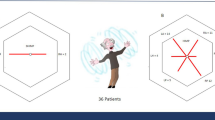Abstract
Improvement of statokinetic stability is a pressing problem of aviation medicine in view of progress in aviation engineering. As the speed and maneuver capability of aircrafts grew, the conflict between a continuous increase in available power and constant psychophysiological abilities of the human body becomes inevitably harder. Statistics evidences that 49.0% of aviation accidents are due to erroneous actions of pilots. Today, tough mental activity is involved in an aviator’s labor, while the body is affected by a broad variety of flight-related factors. Information flow analysis, instant decision making, and control of aircraft strain the psychophysiological human abilities to their limit. All aircrew members must keep being professionally effective throughout the mission. This circumstance warrants the development of appropriate means and methods to improve the statokinetic stability in air and space crews. The objective of this work was to study the psychophysiological dynamics during statokinetic perturbations prior to and after a course of electrical tranquilization of the central nervous system (CNS) in combination with modified Yarotsky’s test (MYT). Statokinetic perturbations were modeled using a continuous Coriolis acceleration accumulation test (CAAT) in a rotating chair. The indices under study included the maximum CAAT tolerance time and the strengths of vestibular sensory, vestibular vegetative, and vestibular somatic reactions. Functional characteristics were tested using complex functional computer stabilography (CFCS). An analysis of the results led to the conclusion that a course of CNS electrical tranquilization in combination with MYT is highly efficient.

Similar content being viewed by others
REFERENCES
Buynov, L.G., Blaginin, A.A., Kotov, O.V., and Sorokina, L.A., Effect of the course of electrical tranquilization of the central nervous system on the statokinetic stability of a man, Aviakosm. Ekol. Med., 2016, vol. 50, no. 2, pp. 69–71.
Glaznikov, L.A., Buynov, L.G., Govorun, M.I., et al., Pathogenetic approach to the development of means and methods to increase the statokinetic sustainability of operators of aerospace profile, Vestn. Otorinolaringol., 2012, no. 4, pp. 33–36.
Gro, L.Ya. and Laions, T.D., Operational awareness in super maneuverable aircraft as a case study, Vestn. Mezhdynar. Akad. Probl. Chel. Aviat. Kosmonavt., 2013, no. 1 (42), pp. 76–86.
Evdokimov, V.I., Kachestvo zhizni i professional’naya uspeshnost’ letnogo sostava (Life Quality and Professional Success of the Aircraft Crews), Moscow: Makchak, 2001.
Zhdan’ko, I.M., Khomenko, M.N., Vorona, A.A., et al., Medical-psychological problems of improvement of the combat efficiency, safety and occupational health of aviation staff in modern conditions, Vestn. Mezhdynar. Akad. Probl. Chel. Aviat. Kosmonavt., 2014, no. 1 (45), pp. 7–12.
Kozlov, V.V. and Medintsev, I.I., Chelovek i bezopasnost’ poletov: Nauchno-prakticheskie aspekty snizheniya aviatsionnoi avariinosti po pichine chelovecheskogo faktora (A Man and Aircraft Safety: Scientific and Practical Aspects for Reduction of Aviation Accidents Due to Human Factors), 2013.
Syroezhkin, F.A., Dvoryanchikov, V.V., Blaginin, A.A., and Buynov, L.G., Modern means of vestibular rehabilitation to improve the statokinetic stability, Voen.-Med. Zh., 2016, vol. 337, no. 4, pp. 36–42.
Ushakov, I.B., Osnovy aviatsionnoi i kosmicheskoi meditsiny (Fundamentals of Aviation and Space Medicine), Moscow, 2007.
Jennings, R.T., Managing space motion sickness, J. Vestibular Res., 1998, vol. 8, no. 1, pp. 67–70.
Albery, W., Bushby, A., Holmes, S.R., et al., SD statistics across NATO flight operations, 78th Annual Scientific Meeting, 2007, p. 40.
Babiyak, V.I., Otorinolaringologiya: uchebnik dlya vuzov (Otorhinolaryngology: Manual for Higher Education Institutions), St. Petersburg, 2012.
Kholin, A.A. and Kholina, E.I., Kinetosis or motion sickness syndrome: treatment and prevention, Med. Sov., 2011, nos. 11–12.
Usachev, V.I., Spatial sense, vestibular and statokinetic systems, XV S”ezd otorinolaringologov Rossii, Tezisy dokladov (XV Congr. Otorinolaringologists of Russia, Abstracts of Papers), St. Petersburg, 1995, vol. 1, pp. 49–54.
Yanov, Yu.K. and Shelepov, A.M., Voennaya otorinolaringologiya (Military Otorinolaringology), Moscow, 2014.
Egorov, A.D. and Yuganov, E.M., Struktura ravnovesiya (The Structure of Equilibrium), Moscow, 2008.
Chapek, A.V., Vestibulosensory reactions and the effectiveness of their training in cadets of the flying schools, in Aviakosmicheskaya meditsina (Aerospace Medicine), Moscow, 1971, vol. 3, pp. 110–117.
Anokhin, P.K., Uzlovye voprosy teorii funktsional’noi sistemy (Milestones in the Theory of Functional System), Moscow, 1980.
Gofman, V.R. and Koryukin, V.E., Tsentral’nye nervnye mekhanizmy v funktsii vestibulyarnogo analizatora (Central Nervous Mechanisms in the Function of the Vestibular Analyzer), St. Petersburg, 1994.
Bekhtereva, N.P., Elektricheskaya stimulyatsiya mozga i nervov u cheloveka (Electrical Human Brain and Nerve Stimulation), St. Petersburg, 2008.
Kastrubin, E.M., Psikhicheskaya samozashchita i neiroenergetika: prakticheskoe rukovodstvo po sovremennoi neiroenergetike (Psychological Self-Defense and Neuroenergetics: Practical Manual on Modern Neuroenergetics), Moscow, 2009.
Author information
Authors and Affiliations
Corresponding author
Additional information
Translated by T. Tkacheva
Rights and permissions
About this article
Cite this article
Glaznikov, L.A., Blaginin, A.A., Sorokina, L.A. et al. Efficiency of Electrical Tranquilization of the Central Nervous System in Combination with Vestibular Training to Improve the Statokinetic Stability. Hum Physiol 44, 753–758 (2018). https://doi.org/10.1134/S0362119718070034
Received:
Published:
Issue Date:
DOI: https://doi.org/10.1134/S0362119718070034




